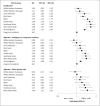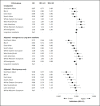Association between end-of-life cancer care and immigrant status: a retrospective cohort study in Ontario, Canada
- PMID: 34078633
- PMCID: PMC8173292
- DOI: 10.1136/bmjopen-2020-042978
Association between end-of-life cancer care and immigrant status: a retrospective cohort study in Ontario, Canada
Abstract
Objective: To compare recent immigrants and long-term residents in Ontario, Canada, on established health service quality indicators of end-of-life cancer care.
Design: Retrospective, population-based cohort study of cancer decedents between 2004 and 2015.
Setting: Ontario, Canada.
Participants: We grouped 13 085 immigrants who arrived in Ontario in 1985 or later into eight major ethnic groups based on birth country, mother tongue and surname, and compared them to 229 471 long-term residents who were ≥18 years at the time of death.
Primary and secondary outcome measures: Aggressive care, defined as a composite of ≥2 emergency department visits, ≥2 new hospitalisations or an intensive care unit admission within 30 days of death; and supportive care, defined as a physician house call within 2 weeks, or palliative nursing or personal support worker home visit within 6 months of death. Multivariable logistic regression was used to examine the association between immigration status and the odds of each main outcome.
Results: Compared with long-term residents, immigrants overall and by ethnic group had higher rates of aggressive care (13.7% vs 17.5%, respectively; p<0.001). Among immigrants, Southeast Asians had the highest use while White-Eastern and Western Europeans had the lowest. Supportive care use was similar between long-term residents and immigrants (50.0% vs 50.5%, respectively; p=0.36), though lower among Southeast Asians (46.6%) and higher among White-Western Europeans (55.6%). After adjusting for sociodemographic characteristics and comorbidities, immigrants remained more likely than long-term residents to receive aggressive care (OR: 1.15, 95% CI 1.09 to 1.21), yet were less likely to receive supportive care (OR: 0.95, 95% CI 0.91 to 0.98).
Conclusions: Among cancer decedents in Ontario, immigrants are more likely to use aggressive healthcare services at the end of life than long-term residents, while supportive care varies by ethnicity. Contributors to variation in end-of-life care require further study.
Keywords: adult oncology; adult palliative care; quality in health care.
© Author(s) (or their employer(s)) 2021. Re-use permitted under CC BY-NC. No commercial re-use. See rights and permissions. Published by BMJ.
Conflict of interest statement
Competing interests: None declared.
Figures




Similar articles
-
Association Between Immigrant Status and End-of-Life Care in Ontario, Canada.JAMA. 2017 Oct 17;318(15):1479-1488. doi: 10.1001/jama.2017.14418. JAMA. 2017. PMID: 28973088 Free PMC article.
-
Comparison of End-of-Life Care Between Recent Immigrants and Long-standing Residents in Ontario, Canada.JAMA Netw Open. 2021 Nov 1;4(11):e2132397. doi: 10.1001/jamanetworkopen.2021.32397. JAMA Netw Open. 2021. PMID: 34726744 Free PMC article.
-
Days Spent at Home before Death from Cancer for Immigrants and Long-Term Residents in Ontario, Canada.J Palliat Med. 2021 Apr;24(4):593-598. doi: 10.1089/jpm.2020.0287. Epub 2020 Dec 22. J Palliat Med. 2021. PMID: 33351717
-
Trends in mental health service utilisation in immigrant youth in Ontario, Canada, 1996-2012: a population-based longitudinal cohort study.BMJ Open. 2018 Sep 17;8(9):e022647. doi: 10.1136/bmjopen-2018-022647. BMJ Open. 2018. PMID: 30224392 Free PMC article.
-
Lung cancer survival by immigrant status: a population-based retrospective cohort study in Ontario, Canada.BMC Cancer. 2024 Sep 7;24(1):1114. doi: 10.1186/s12885-024-12804-7. BMC Cancer. 2024. PMID: 39243029 Free PMC article.
Cited by
-
From Cultural Safety to Anti-Racism: Reflections on Addressing Inequities in Palliative Care.Curr Oncol. 2023 Aug 28;30(9):7920-7925. doi: 10.3390/curroncol30090575. Curr Oncol. 2023. PMID: 37754490 Free PMC article.
-
Inequalities in survival and care across social determinants of health in a cohort of advanced lung cancer patients in Quebec (Canada): A high-resolution population-level analysis.Cancer Med. 2023 Jun;12(11):12683-12704. doi: 10.1002/cam4.5897. Epub 2023 Apr 5. Cancer Med. 2023. PMID: 37017510 Free PMC article.
-
"'We don't want them to have to live out their lives in the hospital": mixed-methods study exploring palliative care needs amongst refugees'.Palliat Care Soc Pract. 2025 Feb 6;19:26323524251317539. doi: 10.1177/26323524251317539. eCollection 2025. Palliat Care Soc Pract. 2025. PMID: 39926420 Free PMC article.
-
Improving equity and wellness in cancer care with people of Latin American and African Descent: a study protocol.Front Oncol. 2025 Feb 26;15:1469037. doi: 10.3389/fonc.2025.1469037. eCollection 2025. Front Oncol. 2025. PMID: 40078189 Free PMC article.
-
Increasing access to palliative care for patients with advanced cancer of African and Latin American descent: a patient-oriented community-based study protocol.BMC Palliat Care. 2023 Dec 20;22(1):204. doi: 10.1186/s12904-023-01323-0. BMC Palliat Care. 2023. PMID: 38115105 Free PMC article.
References
-
- Public Health Agency of Canada . Key health inequalities in Canada. A national portrait, 2018. Available: https://www.canada.ca/content/dam/phac-aspc/documents/services/publicati...
-
- American College of Physicians . Racial and ethnic disparities in health care, updated 2010: policy paper. Available: https://www.acponline.org/acp_policy/policies/racial_ethnic_disparities_...
Publication types
MeSH terms
LinkOut - more resources
Full Text Sources
Medical
Miscellaneous
